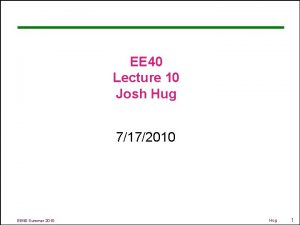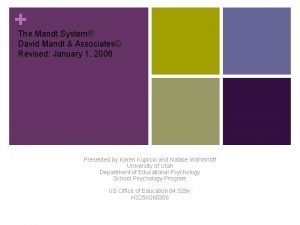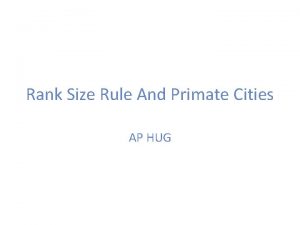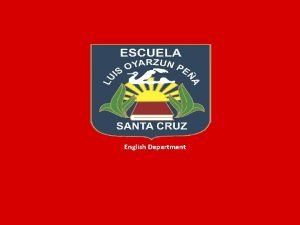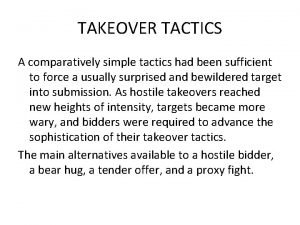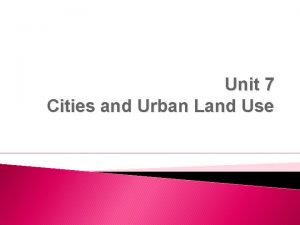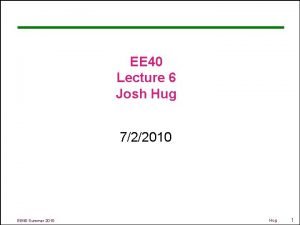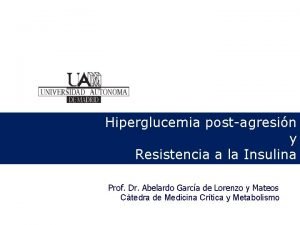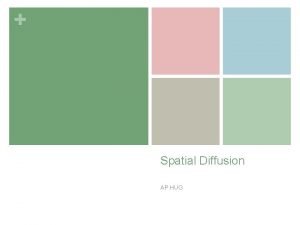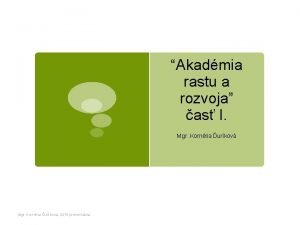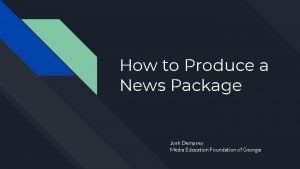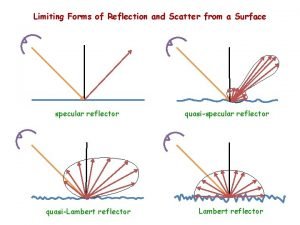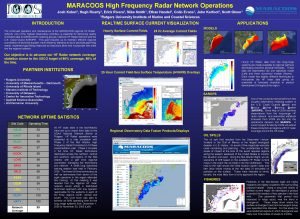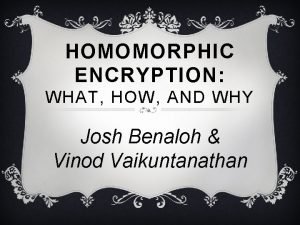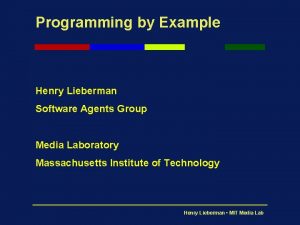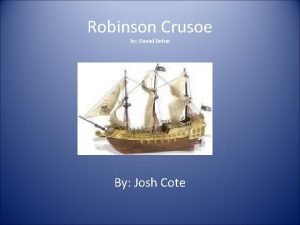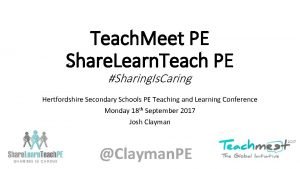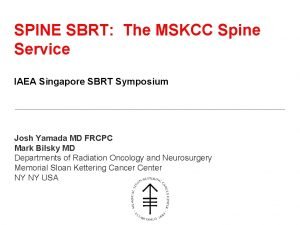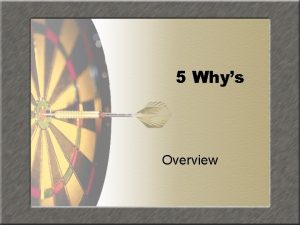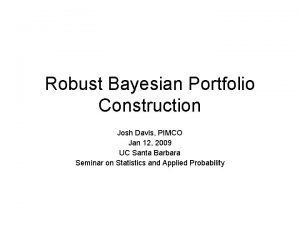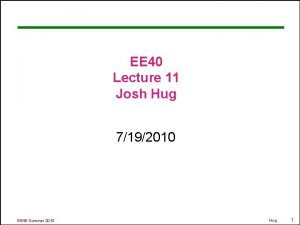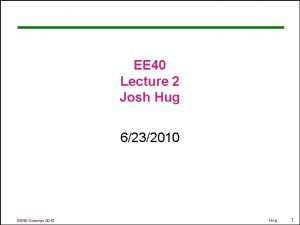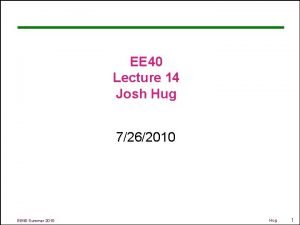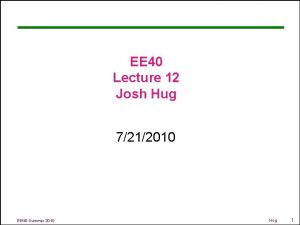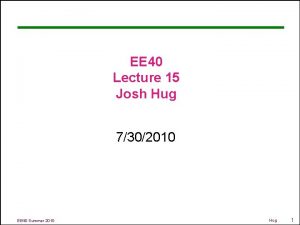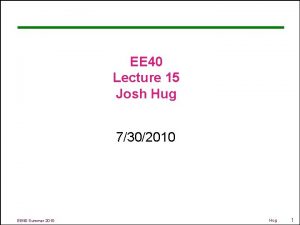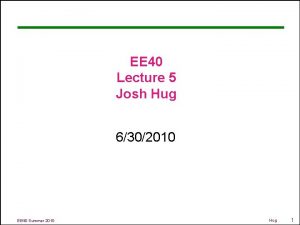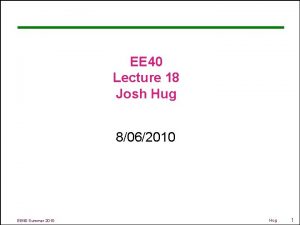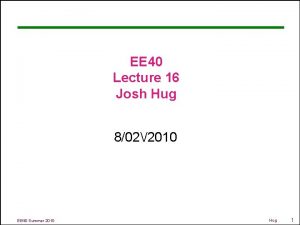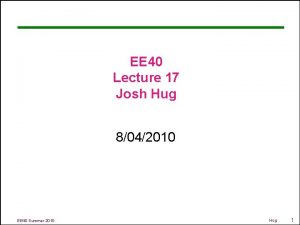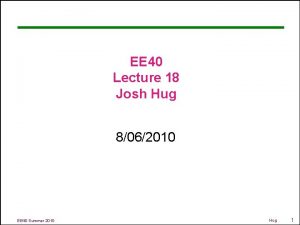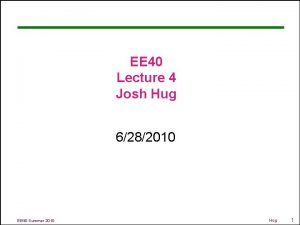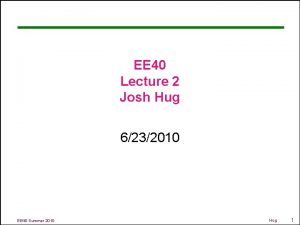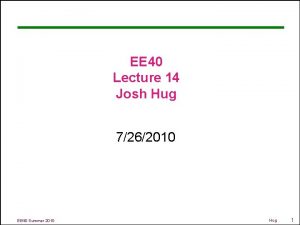EE 40 Lecture 7 Josh Hug 772010 EE



































- Slides: 35

EE 40 Lecture 7 Josh Hug 7/7/2010 EE 40 Summer 2010 Hug 1

Blackboard Stuff • HW 3 concerns • Any general questions people might have EE 40 Summer 2010 Hug 2

General Info • No lab today • Midterm on Friday in class – 12: 10 -1: 30 [be on time!] – No electronic devices – One 8. 5”x 11” (or A 4) sheet of paper • Handwritten anything you want, both sides • HW 4 due next Friday (will be posted Friday) • No positive feedback circuits on the midterm (but there might be on the final) EE 40 Summer 2010 Hug 3

Project 2 • Project 2 spec to be posted over the weekend • If you’d like to do something other than the official project, you can submit a specification for your Project 2: – Team members (up to 3) – Parts list – Schematic • Must have substantial hardware component – Microcontrollers are OK, but your project shouldn’t be about assembly programming – My. DAQ is also OK, but your project shouldn’t be about Lab. VIEW programming • Custom project proposals due WEDNESDAY by 5 PM EE 40 Summer 2010 Hug 4

Guest Mini-Lecture Today • Jeff Jansen from National Instruments will be talking today for the last half hour – My. DAQ data acquisition device • USB device that lets you use your computer in lieu of big bulky specialized test equipment – Can use this device to do labs from home or anywhere else a laptop functions – If anyone wants to use these in labs, we will have 10 of them available – Could be handy for Project 2 • Must have substantial hardware component (can’t just be Lab. VIEW software written for My. DAQ) EE 40 Summer 2010 Hug 5

Course Website • I am assured that the rest of the calendar and the other 5 labs will be posted shortly. Most likely schedule is: – 7/13: Project 1 (buzzer) – 7/14: Sound synthesizer – 7/20: Power supply – 7/21: Active filter lab – 7/27 -8/11: Project 2 • Future reading assignments will be posted 3 days before they’re due – Micro-deadlines are needed for me, too! EE 40 Summer 2010 Hug 6

Op-Amp Saturation • Remember those power ports we’ve been ignoring? EE 40 Summer 2010 Hug 7

Op-Amp Saturation Example • Vin Vo -5 V -12 V -1 V 2 V 12 V 4 V -3 V 6 V -4 V -12 V 1, 512, 312 V EE 40 Summer 2010 Hug 8

Positive Feedback On the board EE 40 Summer 2010 Hug 9

Another Op-Amp Model Revision • EE 40 Summer 2010 Hug 10

Common Mode Signal V 1 + - + 10 V _ -10 V • EE 40 Summer 2010 0 V New Term Hug 11

Common Mode Signal V 1 + - + 10 V _ -10 V • EE 40 Summer 2010 Hug 12

Example of using CMRR • EE 40 Summer 2010 Hug 13

One of many Op-Amp parameters • Typical CMRR is 35, 000 (~90 d. B) – Usually measured in db • CMRRdb=20*log 10(CMRR) • In real life, Op-Amps come with multipage data sheets (as do everything else) EE 40 Summer 2010 Hug 14

How are you feeling about… • How are you feeling about Node Voltage and solving basic circuits? – A. Completely lost – B. A little behind – C. Alright – D. Pretty good – E. Feel like I’ve attained mastery EE 40 Summer 2010 Hug 15

How are you feeling about… • How are you feeling about I-V characteristics and Thevenin and Norton equivalents? – A. Completely lost – B. A little behind – C. Alright – D. Pretty good – E. Feel like I’ve attained mastery EE 40 Summer 2010 Hug 16

How are you feeling about… • How are you feeling about Op-Amp circuits? – A. Completely lost – B. A little behind – C. Alright – D. Pretty good – E. Feel like I’ve attained mastery EE 40 Summer 2010 Hug 17

How are you feeling about… • How are you feeling about the midterm? – A. Terrified – B. A little scared – C. Neutralish – D. Feel prepared – E. Feel like I will do excellently EE 40 Summer 2010 Hug 18

Make up Labs • Do you need a make up lab? • A. Yes • B. No EE 40 Summer 2010 Hug 19

• This is where we stopped EE 40 Summer 2010 Hug 20

UNIT 2 Elements with Memory a. k. a. Energy Storage Elements EE 40 Summer 2010 Hug 21

Preview of Unit 2 • EE 40 Summer 2010 Hug 22

RC Circuits • Taking the Live Demo risk, let’s check out a quick qualitative circuit simulation EE 40 Summer 2010 Hug 23

The Capacitor • The basic idea is pretty simple – Imagine you have two parallel metal plates, both of which have equal and opposite excess charges – Plates are separated by an insulating layer (air, glass, wood, etc) • The charges would love to balance out • Insulator blocks them (just as the ground blocks you from falling into the center of the earth) EE 40 Summer 2010 Hug 24

The Capacitor • EE 40 Summer 2010 Hug 25

The Capacitor • Remember that a voltage is the electrical potential between two points in space EE 40 Summer 2010 Hug 26

The Capacitor EE 40 Summer 2010 + - + - • Hug 27

The Capacitor Zero VC EE 40 Summer 2010 + - Zero current + - Lots of current VC=VS Lots of current Zero of current High VC Zero VC Hug 28

Capacitor Symbol: C or C C Units: Farads (Coulombs/Volt) Electrolytic (polarized) capacitor These have high capacitance and cannot support voltage drops of the wrong polarity (typical range of values: 1 p. F to 1 m. F; for “supercapacitors” up to a few F!) Current-Voltage relationship: ic + vc – Note: vc must be a continuous function of time since the charge stored on each plate cannot change suddenly EE 40 Summer 2010 Hug 29

Node Voltage with Capacitors ic + vc – • On board EE 40 Summer 2010 Hug 30

Ordinary Differential Equations • Inductors, too, give us a simple 1 st order relationship between voltage and current • Node Voltage with memoryless circuits gave us algebraic equations • Node voltage with elements with memory will give us Ordinary Differential Equations (ODEs) • Next week will be a bunch of setting up and solving 1 st and 2 nd order linear ODEs • Higher order and especially nonlinear ODEs are tough to solve. For example… EE 40 Summer 2010 Hug 31

Chua’s Circuit – ODEs are: EE 40 Summer 2010 Hug 32

Chua’s Circuit • Despite simplicity of ODEs • Exhibits chaos! Invented by current UC Berkeley EECS professor Leon Chua in 1983 EE 40 Summer 2010 Hug 33

Capacitors • Useful for – Storing Energy – Filtering – Modeling unwanted capacitive effects, particularly delay EE 40 Summer 2010 Hug 34

Good luck on your midterm! • Now on to Jeff’s presentation EE 40 Summer 2010 Hug 35
 Josh hug
Josh hug Josh hug
Josh hug 01:640:244 lecture notes - lecture 15: plat, idah, farad
01:640:244 lecture notes - lecture 15: plat, idah, farad Pagbati example
Pagbati example Crisis cycle mandt
Crisis cycle mandt Primate city rule example
Primate city rule example Hug simple past
Hug simple past Remote sensing ap hug
Remote sensing ap hug Maumee watershed district
Maumee watershed district Hug gimnazija
Hug gimnazija Verb groups
Verb groups Bear hug takeover
Bear hug takeover Bid-rent theory
Bid-rent theory Embiyax su hug
Embiyax su hug Fast hug bid
Fast hug bid Diffusion
Diffusion The crossover josh character traits
The crossover josh character traits Jasmine richardsom
Jasmine richardsom Josh waitzkin wife
Josh waitzkin wife Josh dempsey shot
Josh dempsey shot Josh starmer book
Josh starmer book Josh wurman
Josh wurman Josh kohut
Josh kohut Josh rosenau
Josh rosenau Josh benaloh
Josh benaloh Dr. josh laxton
Dr. josh laxton Henry
Henry Josh brownlow
Josh brownlow Plot summary of robinson crusoe
Plot summary of robinson crusoe Josh poulson
Josh poulson Share learn teach
Share learn teach Noms score spine
Noms score spine Parker rodenbaugh
Parker rodenbaugh Washington monument 5 whys
Washington monument 5 whys Dr nat wright
Dr nat wright Josh davis pimco
Josh davis pimco

